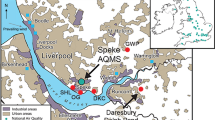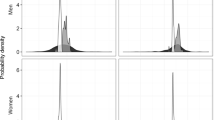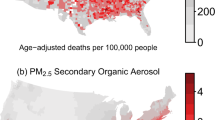Abstract
Many epidemiological studies provide evidence of an association between ambient particles, measured as PM10, and daily mortality. Most of these studies have been conducted in urban areas where PM10 is highly correlated with and dominated by fine particles less than 2.5 μm in diameter (PM2.5). Fewer studies have investigated impacts associated with the fraction of coarse mode particles (between 2.5 and 10 μm in diameter). In a previous study using data from 1989 through 1992 in the Coachella Valley, a desert resort and retirement area east of Los Angeles, we reported associations between PM10 and several different measures of mortality [Ostro B.D., Hurley S., and Lipsett M.J. Air pollution and daily mortality in the Coachella Valley, California: a study of PM10 dominated by coarse particles. Environ. Res. 1999: 81: 231–238]. In this arid environment, coarse particles of geologic origin are highly correlated with and comprise approximately 60% of PM10, increasing to >90% during wind events. This study was intended to repeat the earlier investigation using 10 years (1989–1998) of daily data on mortality and PM10. The last 2.5 years of data also included daily measures of PM2.5, allowing examination of size-specific impacts. To ensure adequate statistical power, we attempted to develop predictive models for both fine and coarse particles to use in analyses of the full 10-year period. An acceptable fit was found only for coarse particles, which were found to be a cubic function of PM10 (R2=0.95). Outcome variables included several measures of daily mortality, including all-cause (minus accidents and homicides), cardiovascular and respiratory mortality. Multivariate Poisson regression analyses using generalized additive models were employed to explain the variation in these endpoints, controlling for temperature, humidity, day of the week, season, and time, using locally weighted smoothing techniques. Pollution lags of up to 4 days were examined. Several pollutants were associated with all-cause mortality, including PM2.5, carbon monoxide and nitrogen dioxide. More consistent results were found for cardiovascular-specific mortality, for which associations were found for coarse particles (RR=1.02; 95% C.I., 1.01–1.04), PM10 (RR=1.03; 95% C.I., 1.01–1.05). None of the pollutants was associated with respiratory-specific mortality. Ozone was not associated with any of the mortality outcomes. These findings are generally consistent with those we previously reported for the Coachella Valley for the period 1989–1992, demonstrating associations between several measures of particulate matter and daily mortality in an environment in which particulate concentrations are dominated by the coarse fraction.
This is a preview of subscription content, access via your institution
Access options
Subscribe to this journal
Receive 6 print issues and online access
$259.00 per year
only $43.17 per issue
Buy this article
- Purchase on Springer Link
- Instant access to full article PDF
Prices may be subject to local taxes which are calculated during checkout
Similar content being viewed by others
Author information
Authors and Affiliations
Corresponding author
Rights and permissions
About this article
Cite this article
OSTRO, B., BROADWIN, R. & LIPSETT, M. Coarse and fine particles and daily mortality in the Coachella Valley, California: a follow-up study. J Expo Sci Environ Epidemiol 10, 412–419 (2000). https://doi.org/10.1038/sj.jea.7500094
Received:
Accepted:
Published:
Issue Date:
DOI: https://doi.org/10.1038/sj.jea.7500094
Keywords
This article is cited by
-
Insights into the mixing of particulate matter and aerosols from different sources in a Caribbean industrial town: composition and possible health effect
Air Quality, Atmosphere & Health (2023)
-
Health impact assessment from exposure to trace metals present in atmospheric PM10 at Ahmedabad, a big city in western India
Environmental Monitoring and Assessment (2021)
-
Extracting mass concentration time series features for classification of indoor and outdoor atmospheric particulates
Acta Geophysica (2020)
-
Atmospheric PM2.5-Bound Polycyclic Aromatic Hydrocarbons (PAHs) in Guiyang City, Southwest China: Concentration, Seasonal Variation, Sources and Health Risk Assessment
Archives of Environmental Contamination and Toxicology (2019)
-
Concentration, sources and human health risk of heavy metals and polycyclic aromatic hydrocarbons bound PM2.5 ambient air, Tehran, Iran
Environmental Geochemistry and Health (2019)



